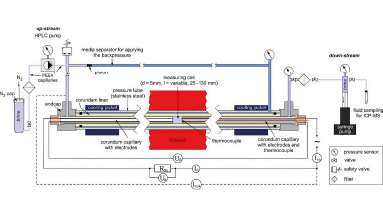High-Temperature Fluid Measuring Cell
Contact:
Web:
Infrastructure belongs to:
The High-Temperature Fluid Measuring Cell is a flow-through device that allows to measure the electrical conductivity of highly corrosive aqueous fluids in dependence of pressure and temperature. So far, the facility was used to study geothermal high-temperature reservoirs at temperatures up to 425°C and fluid pressures up to 350 bar. Beyond the determination of intrinsic fluid properties, the measuring cell is capable to study the effect of fluid–rock interactions at supercritical conditions. As most steels are not corrosion-resist under long-term exposition of supercritical water, the reactor tube was lined with a pipe of corundum ceramic into which two pairs of current and potential electrodes (Pt) as well as a thermocouple (Pt/PtRh) are sealed. The electrode spacing is variable between 25 and 130 mm, what allows the additional integration of solid material into the measuring cell for reactive flow experiments. Fluid samples can be taken down-stream for chemical analysis.
Categories
Disciplinary Keywords
Instrumentation
Laboratory instrumentation
Instrument
-
High Temperature Fluid Measuring Cell
Links
Key Publication
- Kummerow, J., Raab, S. (2015): Temperature Dependence of Electrical Resistivity – Part II: A New Experimental Set-up to Study Fluid-saturated Rocks. - Energy Procedia, 76, 247-255.
- Kummerow, J., et al. (2020): Non-reactive and reactive experiments to determine the electrical conductivities of aqueous geothermal solutions up to supercritical conditions. - Journal of Volcanology and Geothermal Research, 391, 106388.
Relationships
- is part of
